Estimation of Forest NPP and Carbon Sequestration in the Three Gorges Reservoir Area, Using the Biome-BGC Model
Abstract
:1. Introduction
2. Materials and Methods
2.1. Study Area
2.2. Spin-up and Run the Biome-BGC Model
2.3. Parameterization of the Biome-BGC Model
2.4. Validation of The Biome-BGC Model
2.5. Data Processing and Analysis
3. Results
3.1. Interannual Variation in NPP for Different Forest Types
3.2. Temporal Evolution of Forest Productivity and Carbon Sequestration in the TGRA
3.2.1. Forest Productivity
3.2.2. Forest Carbon Sequestration
3.3. Spatial Evolution of Forest Productivity and Carbon Sequestration in the TGRA
4. Discussion
4.1. Influences of Air Temperature and Precipitation on Forest Productivity
4.2. Influences of Land Use Change on Forest Carbon Stocks
5. Conclusions
Author Contributions
Funding
Conflicts of Interest
References
- Richards, K.R.; Stokes, C. A Review of Forest Carbon Sequestration Cost Studies: A Dozen Years of Research. Clim. Chang. 2004, 63, 1–48. [Google Scholar] [CrossRef]
- Landsberg, J.; Waring, R. A generalised model of forest productivity using simplified concepts of radiation-use efficiency, carbon balance and partitioning. For. Ecol. Manag. 1997, 95, 209–228. [Google Scholar] [CrossRef]
- Li, Y.B.; Shao, J.A.; Li, Y.C. The Status and Prospect of Land Use/Land Cover Changes in Three Gorges Reservoir Area. J. Chongqing Norm. Univ. (Nat. Sci.) 2010, 27, 31–35. [Google Scholar]
- Peng, L.; Sun, L. Spatial–temporal changes of rurality driven by urbanization and industrialization: A case study of the Three Gorges Reservoir Area in Chongqing, China. Habitat Int. 2016, 51, 124–132. [Google Scholar] [CrossRef]
- Bieger, K.; Hoermann, G.; Fohrer, N. The impact of land use change in the Xiangxi Catchment (China) on water balance and sediment transport. Reg. Environ. Chang. 2015, 15, 485–498. [Google Scholar] [CrossRef]
- Liu, R.M.; Yang, Z.F.; Shen, Z.Y.; Xing, W.U. Relationship and simulation information system of land ues/cover change and non-point source pollution in Yangtze river basin. Resour. Environ. Yangtze Basin 2006, 15, 372–377. [Google Scholar]
- Hou, L.S.; Cai, Y.L. An essential analysis and review on land use/cover change research. Prog. Geogr. 2004, 23, 96–104. [Google Scholar]
- Zhang, J.; Liu, Z.; Sun, X. Changing landscape in the Three Gorges Reservoir Area of Yangtze River from 1977 to 2005: Land use/land cover, vegetation cover changes estimated using multi-source satellite data. Int. J. Appli. Earth Obs. Geoinf. 2009, 11, 403–412. [Google Scholar] [CrossRef]
- Wang, P.C. Water Conservation of Forest Vegetation in Three Gorges Reservoir Area. Ph.D. Thesis, Chinese Academy of Forestry, Beijing, China, July 2007. [Google Scholar]
- Yao, J. The Study of RS & GIS-Based Forest Landscape Classification and Distribution Pattern in the Three Gorges Reservoir Area. Master’s Thesis, Huazhong Agricultural University, Wuhan, China, June 2008. [Google Scholar]
- Cao, Y.; Zhou, W.; Wang, J.; Yuan, C. Spatial-temporal pattern and differences of land use changes in the Three Gorges Reservoir Area of China during 1975–2005. J. Mt. Sci. 2011, 8, 551–563. [Google Scholar] [CrossRef]
- Fan, Y.J.; Jiang, X.B. Spatial-temporal variation of land use in three gorges’ project area based on space information technologies. Resour. Sci. 2002, 24, 75–80. [Google Scholar]
- Sun, X.X.; Zhang, J.X.; Liu, Z.J. Monitoring the land use dynamics and analyzing its change in time series using imagery in three gorges reservoir area. Resour. Environ. Yangtze Basin 2008, 17, 557–560. [Google Scholar]
- Thornton, P.E. Regional Ecosystem Simulation: Combining Surface- and Satellite-Based Observations to Study Linkages Between Terrestrial Energy and Mass Budgets. Ph.D. Thesis, University of Montana, Missoula, MT, USA, June 1998. [Google Scholar]
- Thornton, P.E.; Running, S.W. An improved algorithm for estimating incident daily solar radiation from measurements of temperature, humidity, and precipitation. Agric. For. Meteorol. 1999, 93, 211–228. [Google Scholar] [CrossRef]
- Thornton, P.E.; Hasenauer, H.; White, M.A. Simultaneous estimation of daily solar radiation and humidity from observed temperature and precipitation: An application over complex terrain in Austria. Agric. For. Meteorol. 2000, 104, 255–271. [Google Scholar] [CrossRef]
- Thornton, P.E.; Law, B.E.; Gholz, H.L.; Clark, K.L.; Falge, E.; Ellsworth, D.S.; Goldstein, A.H.; Monson, R.K.; Hollinger, D.; Falk, M.; et al. Modeling and measuring the effects of disturbance history an climate on carbon and water budgets in evergreen needleleaf forests. Agric. For. Meteorol. 2001, 113, 185–222. [Google Scholar] [CrossRef]
- Ueyama, M.; Harazono, Y.; Kim, Y.W.; Tanaka, N. Response of the carbon cycle in sub-arctic black spruce forests to climate change: reduction of a carbon sink related to the sensitivity of heterotrophic respiration. Agric. For. Meteorol. 2009, 149, 582–602. [Google Scholar] [CrossRef]
- Ueyama, M.; Ichii, K.; Hirata, R.; Takagi, K.; Asanuma, J.; Machimura, T.; Nakai, Y.; Ohta, T.; Saigusa, N.; Takahashi, Y.; et al. Simulating carbon and water cycles of larch forests in East Asia by the BIOME-BGC model with Asia Flux data. Biogeosc. Discussions 2010, 7, 959–977. [Google Scholar] [CrossRef]
- Su, H.X. Analyzing and Simulating the Growth of Picea schrenkiana Forests in Xinjiang Under Global Climate Change. Ph.D. Thesis, Institute of Botany, Chinese Academy of Sciences, Beijing, China, July 2005. [Google Scholar]
- Zeng, H.Q.; Liu, Q.J.; Feng, Z.W.; Wang, X.K.; Ma, Z.Q. GPP and NPP study of Pinus elliottii forest in red soilhilly region based on Biome-BGC model. Acta Ecol. Sin. 2008, 20, 5314–5321. [Google Scholar]
- Fan, M.R.; Yu, X.X.; Zhang, Z.M.; Yu, Y.; Zhao, Y. Net Primary Productivity of a Pinus tabulaeformis Forest in Beijing Mountainous Area in Response to Different Climate Change Scenarios. J. Northeast For. Univ. 2010, 38, 46–48. [Google Scholar]
- Fan, M.R.; Yu, X.X.; Zhang, Z.M.; Shi, Y. The study of the impact of elevated CO2 concentration and climate change on net primary productivity of Quercus variabilis forest in Beijing Mountain Area. Ecol. Environ. Sci. 2010, 26, 1278–1283. [Google Scholar]
- Su, W.; Yu, X.X.; Lv, X.Z.; Fan, M.R.; Zhang, Y. Study on the impact of climate change on net primary productivity of Larix principis-rupprechtii forest in Beijing mountain area. Guangdong Agric. Sci. 2012, 39, 69–72. [Google Scholar]
- Zhang, W.H.; Lv, X.Z.; Yu, X.X.; Fan, M.R. Impact of climate and CO2 change on net primary productivity of Pinus Tabulaeformis forest in Beijing mountain area. Guangdong Agric. Sci. 2012, 39, 4–7. [Google Scholar]
- Li, H. On the Spation-Temporal Simulation of Forest Ecosystem Net Primary Productivity and Net Ecosystem Productivity in Fujian Province. Ph.D. Thesis, Fujian Normal University, Fuzhou, China, July 2008. [Google Scholar]
- Han, Q.F.; Luo, G.P.; Li, C.F.; Feng, Y.X. Simulation of carbon trend in forest ecosystem in northern slope of the Tianshan Mountains based on Biome-BGC. Arid Zone Res. 2014, 31, 375–382. [Google Scholar]
- Law, B.E.; Turner, D.P.; Campbell, J.L.; Sun, O.J.; Van Tuyl, S.; Ritts, W.D.; Cohen, W.B. Disturbance and climate effects on carbon stocks and fluxes across Western Oregon USA. Glob. Chang. Biol. 2004, 10, 1429–1444. [Google Scholar] [CrossRef]
- Schmid, S.; Zierl, B.; Bugmann, H. Analyzing the carbon dynamics of central European forests: comparison of Biome-BGC simulations with measurements. Reg. Environ. Chang. 2006, 6, 167–180. [Google Scholar] [CrossRef]
- Su, H.X.; Sang, W.G.; Wang, Y.X.; Ma, K.P. Simulating Picea schrenkiana forest productivity under climatic changes and atmospheric CO2 increase in Tianshan Mountains, Xinjiang Autonomous Region, China. For. Ecol. Manag. 2007, 246, 273–284. [Google Scholar] [CrossRef]
- Luo, Z.; Sun, O.J.; Wang, E.; Ren, H.; Xu, H.L. Modeling Productivity in Mangrove Forests as Impacted by Effective Soil Water Availability and Its Sensitivity to Climate Change Using Biome-BGC. Ecosystems 2010, 13, 949–965. [Google Scholar] [CrossRef]
- Ueyama, M.; Kai, A.; Ichii, K.; Hamotani, K.; Kosugi, Y.; Monji, N. The sensitivity of carbon sequestration to harvesting and climate conditions in a temperate cypress forest: Observations and modeling. Ecol. Model. 2011, 222, 3216–3225. [Google Scholar] [CrossRef]
- Bond-Lamberty, B.; Gower, S.T.; Goulden, M.L.; McMillan, A. Simulation of boreal black spruce chronosequences: Comparison to field measurements and model evaluation. J. Geophys. Res. Biogeosc. 2015, 111, 1537–1540. [Google Scholar] [CrossRef]
- Holland, E.A.; Dentener, F.J.; Braswell, B.H.; Sulzman, J.M. Contemporary and pre-industrial global reactive nitrogen budgets. Biogeochemistry 1999, 46, 7–43. [Google Scholar] [CrossRef]
- White, M.A.; Thornton, P.E.; Running, S.W.; Nemani, R.R. Parameterization and sensitivity analysis of the BIOME-BGC terrestrial ecosystem model: net primary production controls. Earth Interact. 2000, 4, 1–85. [Google Scholar] [CrossRef]
- Kang, S.; Kimball, J.S.; Running, S.W. Simulating effects of fire disturbance and climate change on boreal forest productivity and evapotranspiration. Sci. Total Env. 2006, 362, 85–102. [Google Scholar] [CrossRef] [PubMed]
- Wu, Y.L.; Wang, X.P.; Li, Q.Y.; Yan, S. Response of broad- leaved Korean Pine forest productivity of Mt. Changbai to climate change: an analysis based on Biome-BGC modeling. Acta Sci. Nat. Univ. Pekin. 2014, 50, 577–586. [Google Scholar]
- He, L.H.; Yu, H.Y.; Lei, X.D. Parameter sensitivity of simulating net primary productivity of Larix olgensis forest based on Biome-BGC model. Chin. J. Appl. Ecol. 2016, 27, 412–420. [Google Scholar]
- Peng, J.J.; He, X.Y.; Chen, Z.J.; Cui, M.X.; Zhang, X.L.; Zhou, C.H. Responses of Pinus tabulaeformis forest ecosystem in North China to climate change and elevated CO2: A simulation based on BIOME-BGC model and tree-ring data. Chin. J. Appl. Ecol. 2012, 23, 1733–1742. [Google Scholar]
- Su, H.X.; Li, G.Q. Simulating the response of the Quercus mongolica forest ecosystem carbon budget to asymmetric warming. Chin. Sci. Bull. 2012, 57, 1544–1552. [Google Scholar] [CrossRef]
- Zeng, L.X.; Wang, P.C.; Xiao, W.F.; Wan, R.; Huang, Z. Allocation of biomass and productivity of main vegetations in Three Gorges Reservoir Region. Sci. Silvae Sin. 2008, 44, 16–22. [Google Scholar]
- Wang, P.C.; Xing, L.J.; Xiao, W.F.; Huang, Z.L.; Pan, L. Organic carbon density and storage of forest ecosystems in three gorges reservoir area. Acta Ecol. Sin. 2009, 29, 97–107. [Google Scholar]
- Xing, L.J. Study on Organic Carbon Storage of Forest Ecosystem in Three Gorges Reservoir Area. Master’s Thesis, Huazhong Agricultural University, Wuhan, China, June 2008. [Google Scholar]
- Fu, T. Carbon Estimation of Main Forest Ecosystem in Three Gorges Reservoir Area Using CBM-CFS3. Ph.D. Thesis, Chinese Academy of Forestry, Beijing, China, July 2013. [Google Scholar]
- Wang, X.J.; Zhang, Y.X.; Huang, G.S.; Ma, W.; Chen, X.Y.; Dang, Y.F. Estimation of forest productivity and carbon storage in three gorges reservoir. Ecol. Sci. 2014, 33, 1114–1121. [Google Scholar]
- Wang, P.C.; Yao, J.; Xiao, W.F.; Zhang, S.G.; Huang, Z.L.; Zeng, L.X.; Pan, L. Topography differentiation characteristics of forest vegetation distribution in the Three Gorges Reservoir area. Res. Environ. Yangtze Basin 2009, 18, 528–534. [Google Scholar]
- Chen, Y.R.; Xiao, W.F.; Feng, Y.; Teng, M.J. Evolution of forest landscape pattern in the three gorges researvoir area during 1992–2012. For. Res. 2017, 30, 542–550. [Google Scholar]
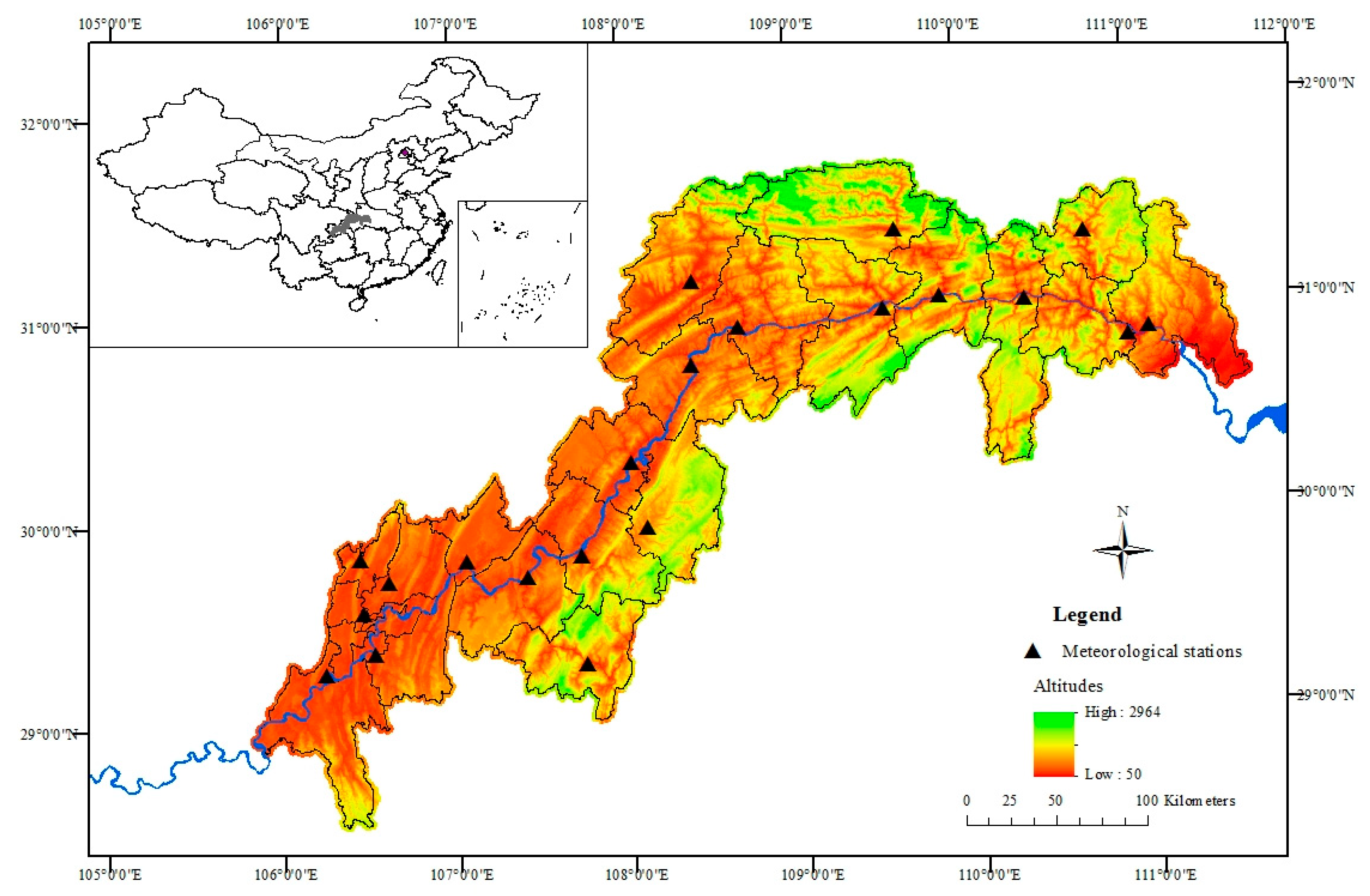

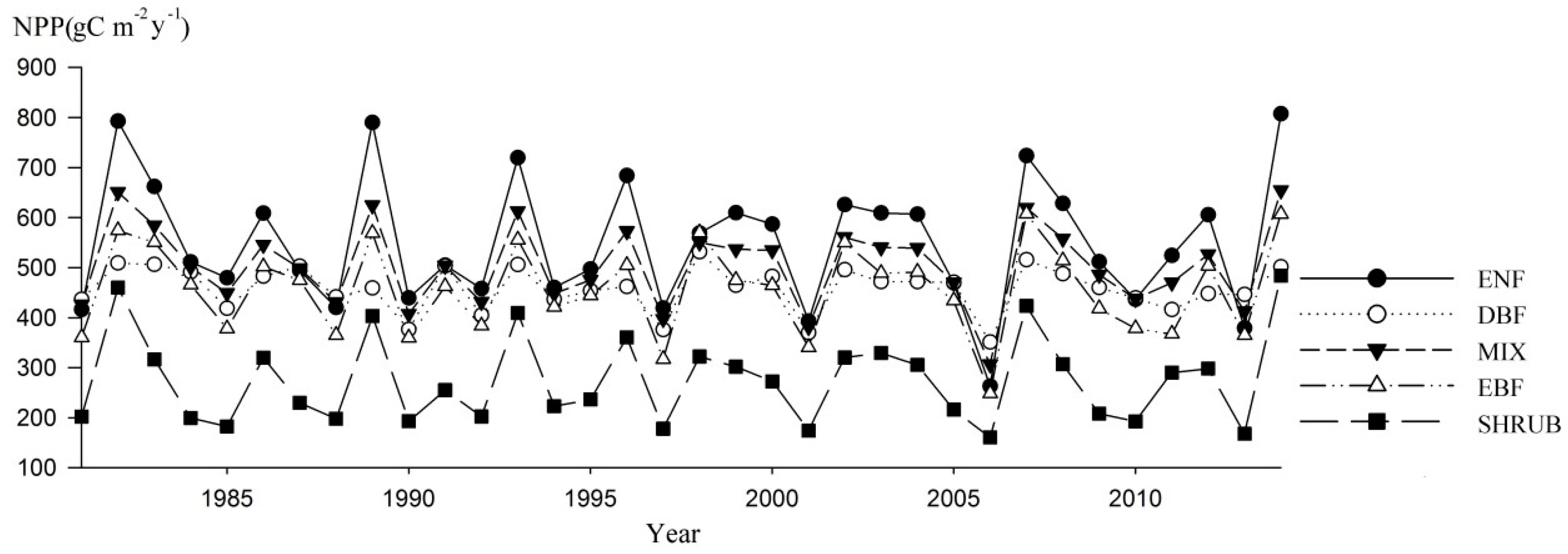
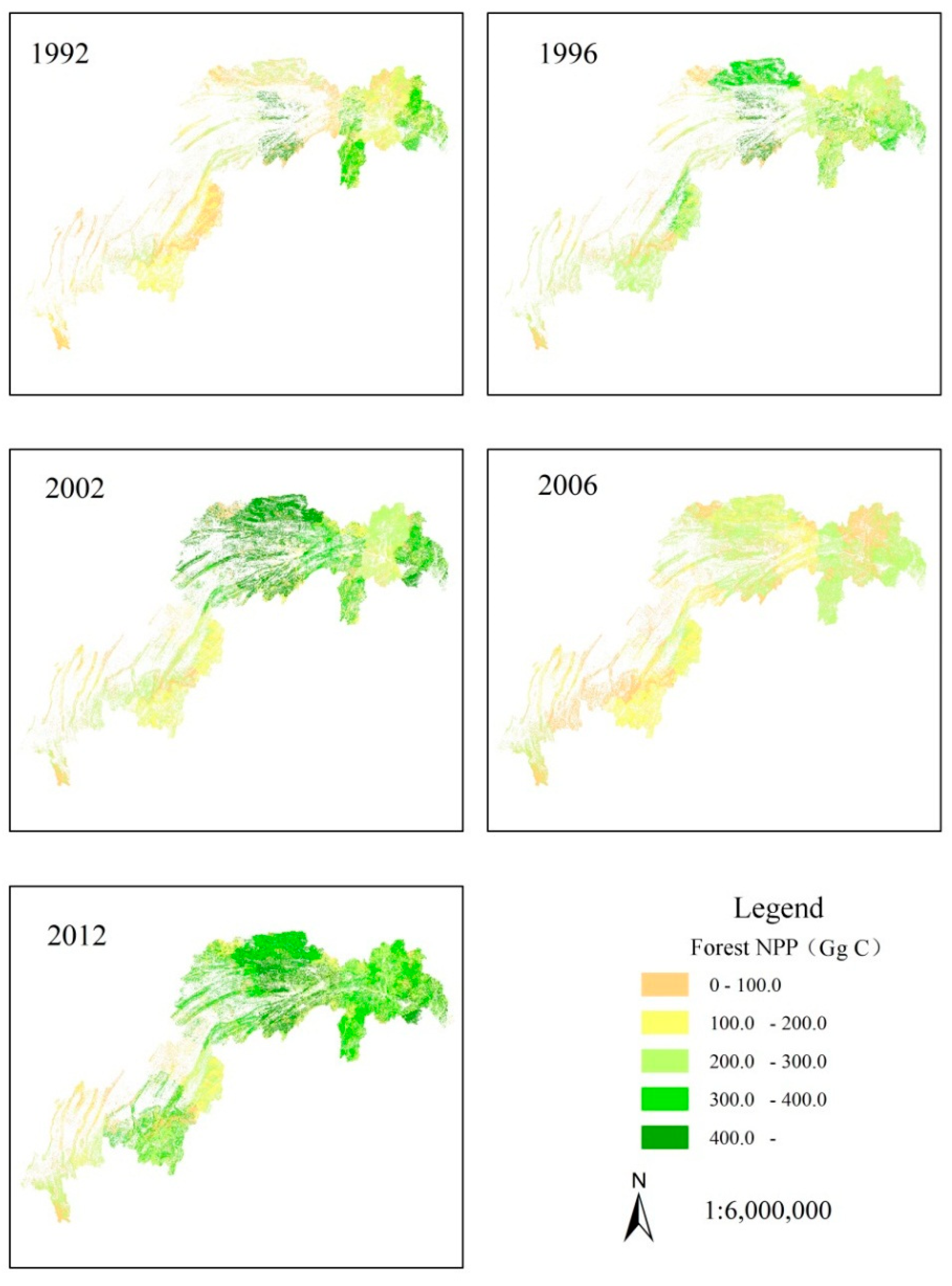
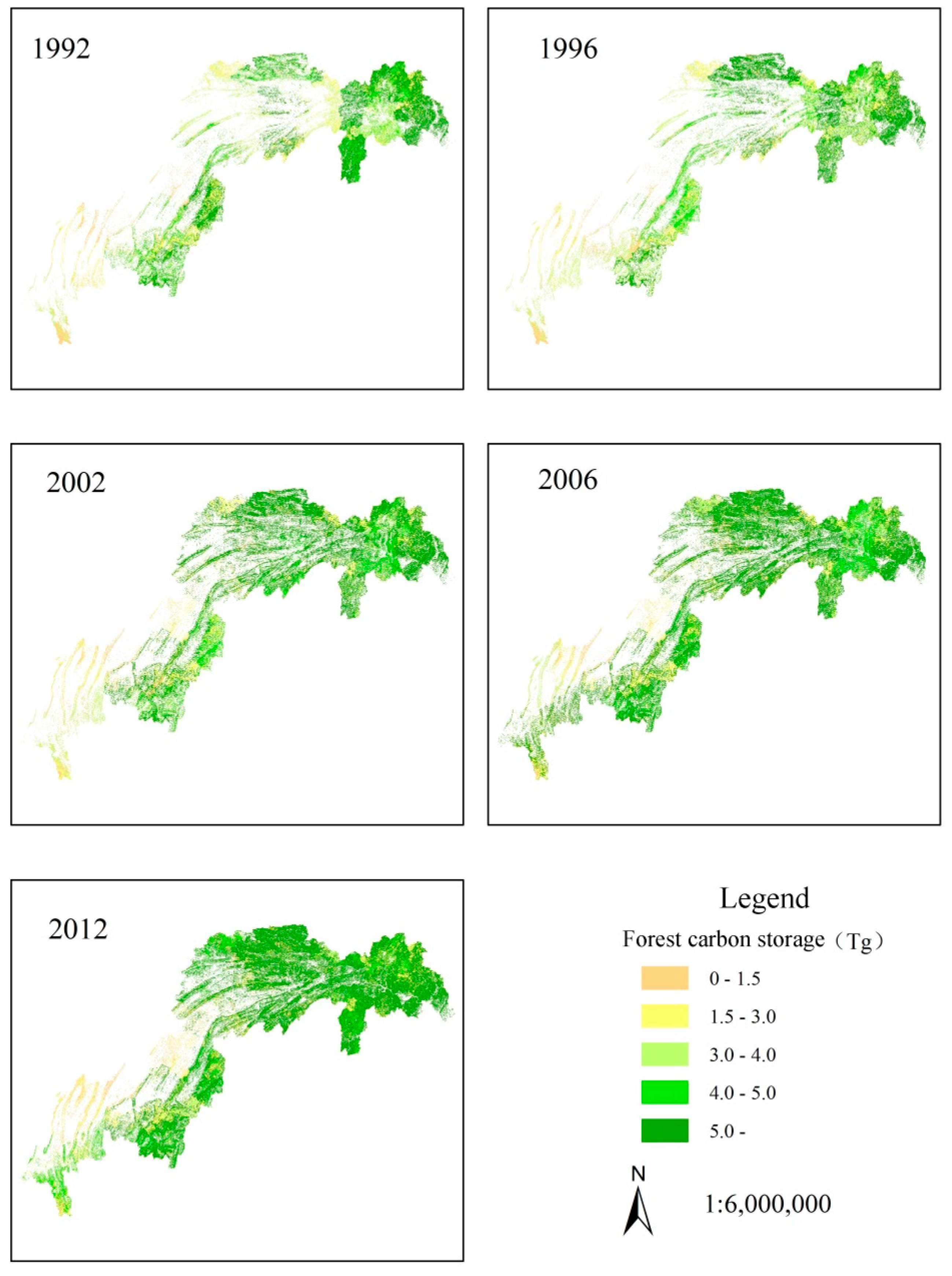
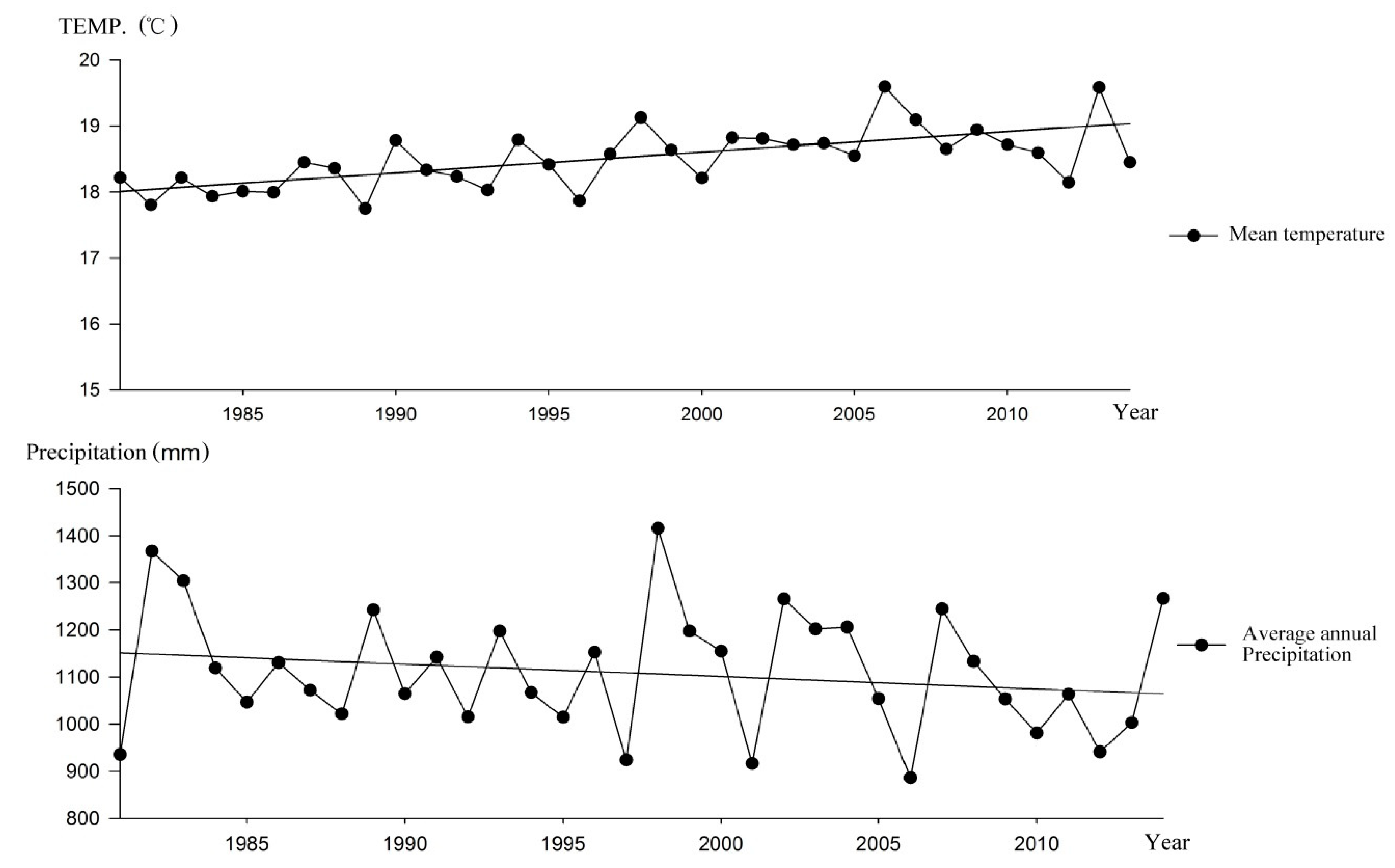
| No | County | Latitude | Longitude | Altitude (m) | Soil Type | Annual Precipitation (cm) |
|---|---|---|---|---|---|---|
| 1 | Fengjie | 31°01′ N | 109°32′ E | 607.3 | Yellow rendzina | 112.79 |
| 2 | Badong | 31°02′ N | 110°22′ E | 334.0 | Dark yellow-brown soil | 109.04 |
| 3 | Zigui | 30°50′ N | 110°58′ E | 295.5 | Yellow soil | 115.86 |
| 4 | Xingshan | 31°21′ N | 110°44′ E | 336.8 | Yellow soil | 101.59 |
| 5 | Wanzhou | 30°46′ N | 108°24′ E | 186.7 | Neutral purple soil | 124.52 |
| 6 | Yiling | 30°42′ N | 111°18′ E | 133.1 | Yellow soil | 122.41 |
| 7 | Chongqing | 29°35′ N | 106°28′ E | 259.1 | Neutral purple soil | 113.58 |
| 8 | Jiangjin | 29°17′ N | 106°15′ E | 261.4 | Yellow soil | 102.41 |
| 9 | Changshou | 29°50′ N | 107°04′ E | 377.6 | Neutral purple soil | 115.59 |
| 10 | Fengdu | 29°51′ N | 107°44′ E | 290.5 | Neutral purple soil | 104.20 |
| 11 | Kaixian | 31°11′ N | 108°25′ E | 216.5 | Calcareous purple soil | 126.01 |
| 12 | Yunyang | 30°57′ N | 108°41′ E | 297.2 | Acid purple soil | 110.78 |
| 13 | Wuxi | 31°24′ N | 109°37′ E | 337.8 | Yellow soil | 109.05 |
| 14 | Wushan | 31°04′ N | 109°52′ E | 275.7 | Yellow rendzina | 102.96 |
| 15 | Zhongxian | 30°18′ N | 108°02′ E | 325.6 | Calcareous purple soil | 119.50 |
| 16 | Shizhu | 29°59′ N | 108°07′ E | 632.3 | Yellow soil | 106.63 |
| 17 | Yubei | 29°44′ N | 106°37′ E | 464.7 | Neutral purple soil | 115.56 |
| 18 | Banan | 29°23′ N | 106°32′ E | 243.6 | Yellow soil | 107.02 |
| 19 | Fuling | 29°45′ N | 107°25′ E | 273.5 | Neutral purple soil | 110.69 |
| 20 | Wulong | 29°19′ N | 107°45′ E | 277.9 | Yellow soil | 102.49 |
| No | Parameters | Unit | ENF | DBF | EBF | SHRUB |
|---|---|---|---|---|---|---|
| P1 | Annual leaf and fine root turnover fraction | year−1 | 0.25 | 1.0 | 0.5 | 0.25 |
| P2 | Annual live wood turnover fraction | year−1 | 0.7 | 0.7 | 0.7 | 0.7 |
| P3 | Annual whole-plant mortality fraction | year−1 | 0.005 | 0.005 | 0.005 | 0.02 |
| P4 | Annual fire mortality fraction | year−1 | 0.005 | 0.0025 | 0.002 | 0.01 |
| P5 | New fine root C:new leaf C | ratio | 0.8 | 0.563 | 1.0 | 0.815 |
| P6 | New stem C:new leaf C | ratio | 2.2 | 0.67 | 1.0 | 0.5 |
| P7 | New live wood C:new total wood C | ratio | 0.071 | 0.16 | 0.22 | 1 |
| P8 | New croot C:new stem C | ratio | 0.29 | 0.77 | 0.3 | 0.655 |
| P9 | Current growth proportion | prop. | 0.5 | 0.5 | 0.5 | 0.5 |
| P10 | C:N of leaves | KgC/KgN | 35.0 | 35.9 | 42.0 | 33.425 |
| P11 | C:N of leaf litter, after retranslocation | KgC/KgN | 93.0 | 65.72 | 49.0 | 75 |
| P12 | C:N of fine roots | KgC/KgN | 58.0 | 43.23 | 42.0 | 52.515 |
| P13 | C:N of live wood | KgC/KgN | 58.0 | 47.23 | 50.0 | 58 |
| P14 | C:N of dead wood | KgC/KgN | 729.0 | 109.9 | 300.0 | 730 |
| P15 | Leaf litter labile proportion | DIM | 0.31 | 0.39 | 0.32 | 0.48 |
| P16 | Leaf litter cellulose proportion | DIM | 0.45 | 0.44 | 0.44 | 0.37 |
| P17 | Leaf litter lignin proportion | DIM | 0.24 | 0.17 | 0.24 | 0.15 |
| P18 | Fine root labile proportion | DIM | 0.34 | 0.29 | 0.30 | 0.41 |
| P19 | Fine root cellulose proportion | DIM | 0.44 | 0.18 | 0.45 | 0.37 |
| P20 | Fine root lignin proportion | DIM | 0.22 | 0.53 | 0.25 | 0.22 |
| P21 | Dead wood cellulose proportion | DIM | 0.71 | 0.66 | 0.76 | 0.71 |
| P22 | Dead wood lignin proportion | DIM | 0.29 | 0.34 | 0.24 | 0.29 |
| P23 | Canopy water interception coefficient | 1/LAI/day | 0.045 | 0.021 | 0.041 | 0.045 |
| P24 | Canopy light extinction coefficient | DIM | 0.5 | 0.7 | 0.7 | 0.55 |
| P25 | All-sided to projected leaf area ratio | DIM | 2.6 | 2.0 | 2.0 | 2.3 |
| P26 | Specific leaf area | m2/KgC | 8.1 | 20.0 | 12.0 | 17.5 |
| P27 | Ratio of shaded SLA:sunlit SLA | DIM | 2.0 | 2.0 | 2.0 | 2 |
| P28 | Fraction of leaf N in Rubisco | DIM | 0.08 | 0.085 | 0.06 | 0.04 |
| P29 | Maximum stomatal conductance | m/s | 0.006 | 0.005 | 0.005 | 0.006 |
| P30 | Cuticular conductance | m/s | 0.00006 | 0.00001 | 0.00001 | 0.00006 |
| P31 | Boundary layer conductance | m/s | 0.09 | 0.01 | 0.01 | 0.02 |
| P32 | Leaf water potential: start of conductance reduction | MPa | −0.65 | −0.6 | −0.6 | −0.81 |
| P33 | Leaf water potential: complete conductance reduction | MPa | −2.5 | −2.3 | −3.9 | −4.2 |
| P34 | Vapor pressure deficit: start of conductance reduction | Pa | 610 | 930.0 | 1800.0 | 970 |
| P35 | Vapor pressure deficit: complete conductance reduction | Pa | 3100 | 4100 | 4100.0 | 4100 |
| Vegetation Type | Observed NPP Value (Mg C hm−2 year−1) | Simulated NPP Value (Mg C hm−2 year−1) | NPP Values from the Literature (Mg C hm−2 year−1) |
|---|---|---|---|
| ENF | 3.60 | 5.53 | Average NPP of various forest types 2.20–5.08 [44] 2.85–6.19 [45] |
| Mixed | 3.22 | 4.94 | |
| DBF | 3.28 | 4.35 | |
| EBF | 4.55 | 4.41 | |
| Shrub | 2.81 | 2.86 |
| Forest Type | Vegetation Carbon Density (Mg hm−2) | Litter Carbon Density (Mg hm−2) | Soil Carbon Density (Mg hm−2) | Total Carbon Density (Mg hm−2) | ||||||||
|---|---|---|---|---|---|---|---|---|---|---|---|---|
| Biome-BGC | CBM-CFS3 | Observed Values | Biome-BGC | CBM-CFS3 | Observed Values | Biome-BGC | CBM-CFS3 | Observed Values | Biome-BGC | CBM-CFS3 | Observed Values | |
| ENF | 35.04 | 31.94 | 24.04 | 4.27 | 12.75 | 2.87 | 65.45 | 47.81 | 98.40 | 104.76 | 92.50 | 125.31 |
| Mixed | 31.35 | 36.01 | 28.85 | 3.86 | 25.72 | 2.28 | 65.65 | 76.49 | 71.10 | 100.87 | 138.21 | 102.23 |
| DBF | 27.67 | 33.03 | 26.20 | 3.46 | 18.52 | 2.99 | 65.85 | 61.27 | 96.70 | 96.98 | 112.82 | 125.89 |
| EBF | 26.80 | 41.84 | 39.71 | 2.87 | 17.40 | 2.94 | 63.97 | 58.82 | 67.60 | 93.65 | 118.06 | 110.25 |
| Shrub | 11.51 | 8.67 | 1.44 | 1.30 | 67.30 | 82.90 | 80.25 | 92.87 | ||||
| Year | NPP (Tg C) | Average NPP (Mg C hm−2 year−1) | |||||
|---|---|---|---|---|---|---|---|
| ENF | MIX | DBF | EBF | Shrub | Total | ||
| 1992 | 3.433 | 1.611 | 1.208 | 0.369 | 1.206 | 7.827 | 3.833 |
| 1996 | 5.058 | 1.971 | 1.476 | 0.481 | 2.352 | 11.338 | 5.437 |
| 2002 | 6.656 | 2.192 | 1.55 | 0.474 | 2.474 | 13.346 | 5.235 |
| 2006 | 3.207 | 1.338 | 1.129 | 0.228 | 1.269 | 7.171 | 2.415 |
| 2012 | 7.067 | 2.924 | 1.778 | 0.474 | 2.756 | 14.999 | 4.465 |
| Year | Carbon Storage (Tg) | |||
|---|---|---|---|---|
| Vegetation | Litter | Soil | Total | |
| 1992 | 54.53 | 6.678 | 139.637 | 200.845 |
| 1996 | 55.707 | 6.814 | 142.607 | 205.128 |
| 2002 | 68.872 | 8.417 | 172.795 | 250.084 |
| 2006 | 80.899 | 9.884 | 200.916 | 291.699 |
| 2012 | 90.117 | 11.016 | 227.288 | 328.421 |
| Annual Temperature | NPP | |||||
|---|---|---|---|---|---|---|
| DBF | EBF | ENF | Shrub | MIX | ||
| Annual temperature | 1 | −0.235 ** | −0.242 ** | −0.321 ** | −0.248 ** | −0.319 ** |
| DBF NPP | 1 | 0.814 ** | 0.657 ** | 0.673 ** | 0.820 ** | |
| EBF NPP | 1 | 0.883 ** | 0.857 ** | 0.932 ** | ||
| ENF NPP | 1 | 0.938 ** | 0.970 ** | |||
| Sbrub NPP | 1 | 0.929 ** | ||||
| MIX NPP | 1 | |||||
| Annual Precipitation | NPP | |||||
|---|---|---|---|---|---|---|
| DBF | EBF | ENF | Shrub | MIX | ||
| Annual Precipitation | 1 | 0.609 ** | 0.704 ** | 0.723 ** | 0.743 ** | 0.744 ** |
| DBF NPP | 1 | 0.814 ** | 0.657 ** | 0.673 ** | 0.820 ** | |
| EBF NPP | 1 | 0.883 ** | 0.857 ** | 0.932 ** | ||
| ENF NPP | 1 | 0.938 ** | 0.970 ** | |||
| Shrub NPP | 1 | 0.929 ** | ||||
| MIX NPP | 1 | |||||
© 2019 by the authors. Licensee MDPI, Basel, Switzerland. This article is an open access article distributed under the terms and conditions of the Creative Commons Attribution (CC BY) license (http://creativecommons.org/licenses/by/4.0/).
Share and Cite
Chen, Y.; Xiao, W. Estimation of Forest NPP and Carbon Sequestration in the Three Gorges Reservoir Area, Using the Biome-BGC Model. Forests 2019, 10, 149. https://doi.org/10.3390/f10020149
Chen Y, Xiao W. Estimation of Forest NPP and Carbon Sequestration in the Three Gorges Reservoir Area, Using the Biome-BGC Model. Forests. 2019; 10(2):149. https://doi.org/10.3390/f10020149
Chicago/Turabian StyleChen, Yaru, and Wenfa Xiao. 2019. "Estimation of Forest NPP and Carbon Sequestration in the Three Gorges Reservoir Area, Using the Biome-BGC Model" Forests 10, no. 2: 149. https://doi.org/10.3390/f10020149
APA StyleChen, Y., & Xiao, W. (2019). Estimation of Forest NPP and Carbon Sequestration in the Three Gorges Reservoir Area, Using the Biome-BGC Model. Forests, 10(2), 149. https://doi.org/10.3390/f10020149





